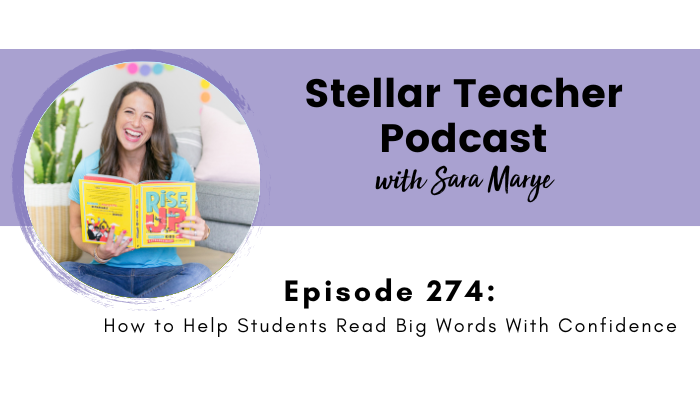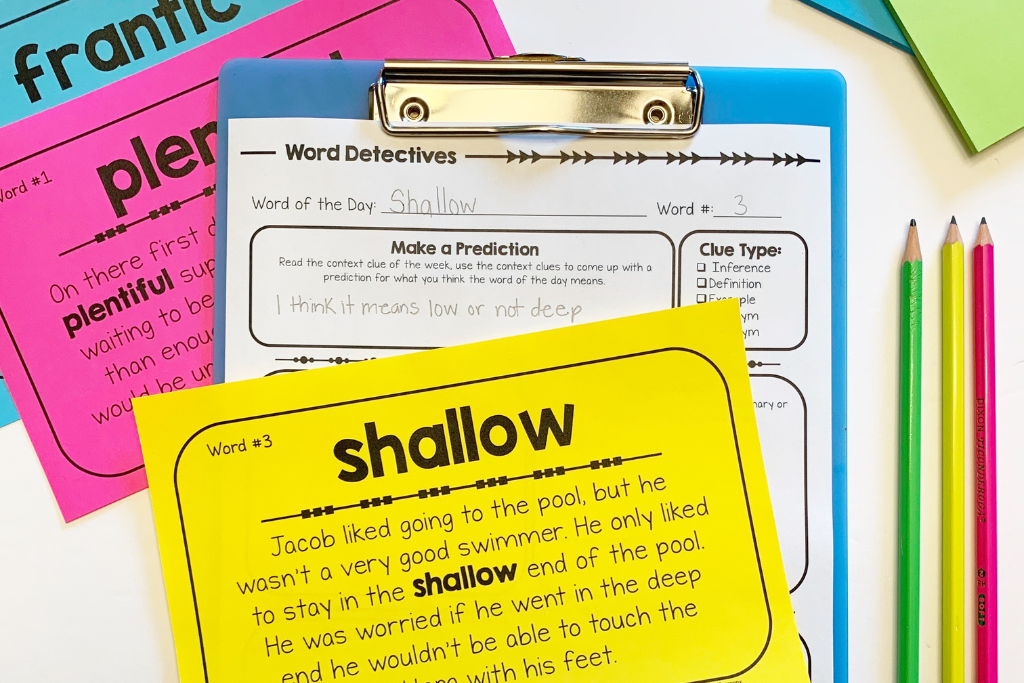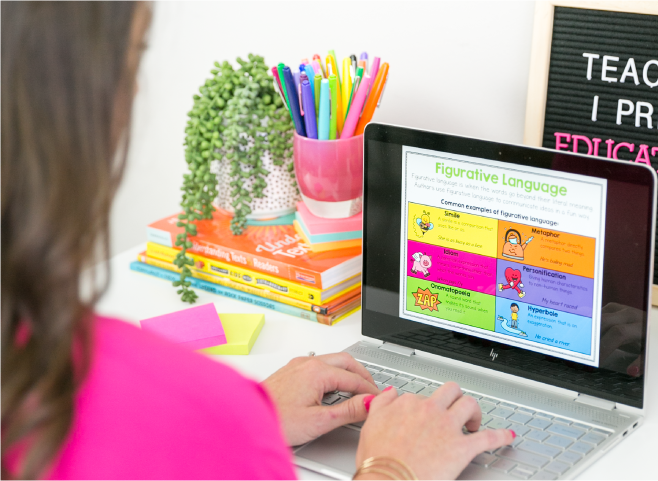
Click play below to listen to tips for helping students read big words.
In this episode of The Stellar Teacher Podcast, I share a practical, step-by-step strategy to help upper elementary students tackle multi-syllabic words with confidence. I talk about the challenges students face when they see long, unfamiliar words, why simple prompts like “sound it out” often don’t work, and how we can give students the tools they need to break words into manageable parts. This episode is for teachers who want actionable strategies they can introduce in their classroom right away.
I walk listeners through the Big Words Strategy, a five-step approach that helps students identify prefixes, suffixes, roots, vowels, and syllables before putting the word together and pronouncing it. I explain how this strategy builds decoding skills while also supporting comprehension and vocabulary development. I also share tips for modeling the strategy effectively, providing guided practice, and supporting students who might not have a strong background in phonics or word study.
We also cover common roadblocks you might encounter when teaching this strategy and practical solutions to keep students on track, including slowing down the pace, using color-coded tools, and pairing students for peer feedback. I emphasize the importance of repeated practice, approximation, and consistent reinforcement to help students feel confident with complex words. This episode gives you a research-backed, easy-to-implement strategy that strengthens reading skills, supports fluency, and empowers your students to tackle big words independently.
In this episode on helping students read big words, I share:
- How to break down multi-syllabic words into manageable chunks so students can read them confidently.
- Strategies to model and practice the Big Words Strategy in your classroom.
- Tips for supporting students who struggle with phonics, word study, or decoding long words.
- Ways to integrate vocabulary and comprehension while teaching students to decode big words.
- Techniques to help students slow down, analyze words carefully, and give peer feedback.
- Practical ideas for making the Big Words Strategy a consistent part of your reading instruction.
Resources:
- How To Read Big Words Poster
- Most Common Prefixes & Suffixes
- Join The Stellar Literacy Collective
- Sign up for my Private Podcast: Confident Writer Systems Series
- Sign up for my FREE Revision Made Easy email series
- If you’re enjoying this podcast, please leave a review on Apple Podcasts!
Related Episodes and Blog Posts:
- Episode 218, A 5-Step Process to Help Students Read Multisyllabic Words
- Episode 207, How to Help Students Read Multisyllabic Words (SOR Summer Series Part 6)
- Blog: Cracking the Code to Reading Proficiency: A Guide to Prefixes and Suffixes
Connect with me:
- Join my newsletter
- Shop my TPT store here
- Subscribe to our YouTube channel
- Instagram: @thestellarteachercompany
- Facebook: The Stellar Teacher Company
More About Stellar Teacher Podcast:
Welcome to the Stellar Teacher Podcast! We believe teaching literacy is a skill. It takes a lot of time, practice, and effort to be good at it. This podcast will show you how to level up your literacy instruction and make a massive impact on your students, all while having a little fun!
Your host, Sara Marye, is a literacy specialist passionate about helping elementary teachers around the world pass on their love of reading to their students. She has over a decade of experience working as a classroom teacher and school administrator. Sara has made it her mission to create high-quality, no-fluff resources and lesson ideas that are both meaningful and engaging for young readers.
Each week, Sara and her guests will share their knowledge, tips, and tricks so that you can feel confident in your ability to transform your students into life-long readers.
Tune in on your favorite podcast platform: Apple, Google, Amazon, Spotify, Castbox, and more! If you’re loving this podcast, please rate, review, and follow!
Podcast (stellar-teacher-podcast): Play in new window | Download
Hey there, stellar teachers. Welcome back to another episode of the Stellar Teacher Podcast. I am so glad you’re joining me today. As we settle into the school year and enter the middle of October, I know this time of year can feel busy and hectic. We’re well past the honeymoon phase, and while you want to continue improving your teacher craft and learning new strategies, it can also feel overwhelming to have this long laundry list of things you feel like you need to try and test out.
So what we’re going to do on the podcast for the next couple of weeks is really focus on shorter, actionable strategies. Each episode, we’re going to talk about just one thing—a strategy that you can take back into your classroom that very day. The goal is simple: you’ll listen, hear the strategy, and immediately bring it to your students in a relatively easy way. And then, of course, you can start seeing results.
Today, we’re diving into a short and actionable strategy to help your students when they get stuck decoding multi-syllabic words. Think about your current group of students. Do you have a student who freezes up when they see a big word like unexplainable or miscommunication—something with a lot of letters? Really big words can feel intimidating to our students, and if we’re being honest, sometimes even we stumble on them. I read a lot, and sometimes I say a big word and think, “Whoa. I need to pause and really think about how to pronounce that.”
Multi-syllabic words can be a major roadblock for upper elementary students. And here’s the problem: the further students move up in grades, the longer and more complex words become. Ultimately, our students cannot avoid them—they have to learn how to read them, and we really want them to feel competent when they encounter a big word.
When students struggle with big words, our natural response is to tell them to “sound it out,” right? Slow down and just sound it out. But here’s the thing: that prompt often doesn’t work. If students don’t have a strong background in phonics and morphology, and if they don’t know much about word study, they likely don’t have the tools or strategies to properly sound out a big word.
So what happens? They see a big word, get overwhelmed, and don’t know how to read it. And we say, “Yeah, sound it out.” And they respond, “I don’t know what that means. I don’t know the sounds in this word. I don’t know how to break it up.” When we see a word with so many letters, do we look at individual letters? Groups of two? Groups of three? What are we even looking for?
That’s why today I want to walk you through one of my favorite tools: the Big Words Strategy. This strategy gives students a step-by-step approach to breaking apart longer words so they can read them, and perhaps even more importantly, understand them. The strategy is simple, easy to teach, and something you can introduce to your students this week.
To make it even easier, we have a free poster that walks you and your students through the strategy. You can download it at stellarteacher.com/bigwords. Plan to teach it to your students sometime this week!
So this strategy has five steps. I’m going to quickly walk you through them, and I’ll use the word unexplainable as an example. This is also the same word used on the poster. This is definitely one of those strategies where I think, “It would be so much easier if I could just show you,” but it’s actually pretty easy to explain as well.
The first thing you want your students to do is, right when they see a big word, break it apart into smaller chunks so they can read each chunk and then put them all together. We’re going to have them identify different word parts. The first step is to circle any prefixes they see. It’s important that we don’t just say “circle the prefix,” because sometimes words have more than one prefix. So we tell students to circle all the prefixes. In the word unexplainable, they would put a circle around un for the prefix.
Step two is to put a box around the suffix. Again, sometimes there’s more than one suffix, so students should be looking for the different word parts. In unexplainable, they would put a box around able. These first two steps are relatively easy because students usually know that prefixes appear at the beginning of a word and suffixes appear at the end. They’ll naturally look for those parts and separate them, so in this case, they’ll separate un and able.
Step three is to look at what’s left. In this case, the word explain remains. Some students might recognize this as a word and can put it together with the prefix and suffix. Some students might need to break it apart further—maybe recognizing ex as another prefix and circling it. Others might still be unsure and will focus on the root or base of the word.
Next, students underline the vowels and then break the word into syllables. We underline the vowels because every syllable contains a vowel sound, and often, vowels are what trip students up. Pinpointing the vowels makes it easier for them to break apart the sounds.
Once students have identified all the word parts they can, it’s okay if there are some parts they aren’t sure about. If they can identify even four of the five word parts in a big word, that’s usually enough for them to successfully read the entire word.
So step number four is to have students say the word parts slowly. In this case, it would be un-ex-plain-able. Then we want them to say the entire word. They might need to say the word parts slowly a few times before they can say the whole word, but hopefully, they’re able to see the different parts and put together the entire word, unexplainable.
That’s it. It’s a simple strategy, yet it empowers students and helps them feel much more confident tackling big words. Ultimately, the Big Words Strategy works because it combines decoding skills with vocabulary awareness, which is crucial in upper elementary. Getting students to read the word correctly is half the battle, but they also need to understand the meaning. When students break up words into their morphemes—the prefixes, suffixes, and roots, as they do in this strategy—they are encouraged to think about both the pronunciation and the meaning of the word.
The strategy works for several other reasons. First, it’s structured, giving students a starting point. Without it, they might skip over the word or try to sound out each individual letter, which can become tedious, especially as words get longer. Letters can make different sounds when paired in different combinations, so giving students a clear starting place is really helpful.
It’s also flexible. It can work with any big word. For example, in upper elementary, students might see a word with two or more prefixes, like disentanglement, which has dis and en. This strategy helps them identify both prefixes. They might also encounter words with multiple suffixes, like respectfully, which has ful and ly. Being able to separate out the different word parts makes it much easier for students to read these words.
The strategy is also easy to model. You can and should model it for students often. You could start today with a word from your read-aloud, science, or social studies lessons and go through this process with your students daily. That’s how it becomes automatic. Once students internalize the process, they’ll feel much more confident when they encounter unfamiliar words in their reading.
Even though this strategy is simple and easy, teaching isn’t always smooth sailing. Let me walk through a couple of potential roadblocks. First, students might not know any prefixes or suffixes. Hopefully, by upper elementary, students will have some knowledge of prefixes and suffixes, but if it’s limited, that’s a signal to spend time teaching these word parts. They’re useful both for reading and comprehension. We always suggest starting with the most common ones, like un, re, ing, and ed. If you want a list of the most common prefixes and suffixes, you can download one at stellarteacher.com/prefix.
Another thing you might notice is, what if students rush through the strategy and miss helpful word parts? They don’t identify them because they’re just rushing through it. I think this is actually to be expected, especially if you are teaching a group of students who haven’t had strong phonics or word study instruction in the past. If this is really the first time students are being prompted to slow down and actually look at word parts, then it’s normal that this won’t be automatic for them.
A few things you can do to help students slow down include modeling a slower pace and showing the importance of looking closely at the word and analyzing it. You could also have students use color-coded pencils or pens for each step—circle the prefix in blue, put a box around the suffix in red, and underline what’s left with purple. This forces them to slow down and pay closer attention to the word.
Students can also work in partnerships to give peer feedback. If students have limited word-part knowledge, provide them with a resource listing common prefixes, suffixes, and roots, giving them a set of word parts to look for in words.
Teachers often wonder what to do if a student can identify the word parts but struggles to put them together. They may identify the prefixes, suffixes, and roots but have difficulty pronouncing them correctly. Identifying word parts is the easy part; putting them together is the challenge. Some strategies that help include modeling and doing lots of guided practice, showing students while engaging them as a whole group.
Encourage students to use approximation—if they don’t know for sure, have them give their best guess. Even if they mispronounce a syllable or prefix or suffix, they can adjust as they think, “Does this sound like a word I’ve heard before?” Continued practice is also essential. Just because this is challenging doesn’t mean students should abandon the strategy. The more they use it, the more fluent they’ll become with reading big words.
If you want a head start, we’ve created a free Big Words Strategy poster that you can use with your students. Head to stellarteacher.com/bigwords to grab your free download today. It’s a great visual reminder of the steps and something you and your students can use this week as you introduce the strategy.
That’s it for this episode. Go ahead and introduce it to your students. If you do, we’d love to hear about it! Snap a photo of the Big Words poster somewhere in your classroom and share it with us on Instagram. You can send it in a DM or tag us in your stories or posts at The Stellar Teacher Company. We always love seeing what’s happening in your classrooms.
If you found this episode helpful, or if you enjoy the Stellar Teacher Podcast in general, we would really appreciate it if you shared it with a teacher friend or coworker at your school. Word of mouth is the best way for us to grow our podcast audience, which ensures we can continue sharing new episodes with you.
As always, thank you for tuning in and listening. If nobody has told you today, the work you do really does matter. Your students are so lucky to have you. The fact that you are listening to this podcast because you want to become the best teacher you can be says so much about you. Thank you for tuning in. I’ll see you back here next week.








Leave a Comment
You must be logged in to post a comment.